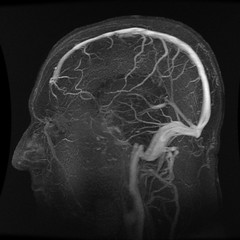 Image by ziggy fresh via Flickr
Image by ziggy fresh via Flickr
If you don't look too closely, the physical me from my pre-diagnosis days pretty much looks the same as the physical me now; I still have my full complement of limbs and appendages, though only half of them still function, and even those that work are being trampled on by the incessant march of MS. Upon closer inspection, my very weak right arm and leg have become noticeably thinner, and are often held at strange angles, due to the spasticity and weakness brought about by the disease. So I can't really say the effects of the illness are all that invisible.
Still, if I take the time to straighten out all of the stiff and weak parts (yes, the magic of MS, abracadabra, can make limbs both stiff and weak), and pose myself just so, when standing still in front of a mirror, the guy looking back at me is just about indistinguishable from that healthy fellow I used to know about seven years ago. Of course, the slightest movement shatters this illusion, but somehow I find it comforting to know that I can still approximate "normal", if only for a moment or two, even if it takes a very abnormal amount of effort to do so. Knowing that there is a good chance that I'll no longer be able to pull off this parlor trick at some point in the future makes my ability to do so now all the more precious.
The changes brought on by MS leave me more and more defined not by what I can do, but by what I can’t. As my "can't do" list grows, constant adjustments need to be made, the most difficult of which aren't changes in physical routines, but revisions in attitude, and in the very definition of "self". Who is this new me, this clumsy creature who needs 30 minutes to put on socks, pants, and shirt, and who can no longer negotiate a childproof cap?
We live in a society that celebrates individual achievement, whose very founding document is a "Declaration of Independence". American mythology is stocked with figures that embody the ideal of independence; sports heroes, legendary entrepreneurs, and historical characters who pull themselves up by their bootstraps and battle their way through every imaginable adversity until with sheer guile and guts they eclipse mere success and ascend the very pinnacle of absolute triumph.
We don't generally celebrate folks who can't cut their own pork chop, or button their own shirt. Yet that's just where I now find myself, very often in situations where the mind is willing, but the body is unable. The physical challenges posed by MS come bundled with the mental hurdles the disease erects. Pride and ego are tremendous obstacles, sometimes even more so than an inability to hold a pen. As my disease has progressed, I've found myself increasingly incapable of doing everyday tasks, the kinds of things most people have the luxury of taking completely for granted. Try opening a carton of orange juice or a bag of chips with only one hand. Good thing I still have my teeth, because they certainly do come in handy (pun intended).
Yet, despite my increasing struggles, for a long time I held tenaciously to that ideal of total independence, an overgrown cranky toddler screaming to the whole fracking world, "I want to do it myself!" Caught in a vicious cycle, the more I struggled with some task, the more frustrated I became, which made me all the more resolute that I would do the damned thing myself.
My wife Karen would often watch from the sidelines, silently sensing the importance of allowing me to come, in my own time, to the realization that asking for help would not diminish me in her eyes or the eyes of the world at large. When finally my level of aggravation would hit the red zone, and I'd look reluctantly in her direction, she'd be there to save the day, always in a good-humored and affectionate way that instantly transformed my raging frustration into gentle gratitude.
Overcoming pride, and a lifetime of indoctrination into the tribe of independence, has been one of the greatest obstacles MS has thrown my way. To admit need, to make a declaration of dependence, requires both tremendous strength and a final acceptance of your situation. It's an admission of vulnerability in a world that seems to delight in dismantling the vulnerable, and a recognition that the situation, dreadful as it may be, has become your new reality.
Yet, once the acknowledgment of need is made, a transformation of sorts takes place. The interdependence that we all have on one another becomes clear and unthreatening, and the understanding dawns that welcoming the offer of a helping hand enriches both the helper and the one being helped. Accepting the assistance of a loved one, friend, or stranger not only makes life easier on me, it allows the person offering their assistance the chance to exercise their humanity and to feel good about themselves. In the parlance of corporate psychobabble, it's a classic win-win situation.
I decided, finally, that asking for help simply keeps one from being helpless, and does not represent capitulation or weakness of character. Obstinately struggling with the lid of a jar or with the clunky zipper of a winter coat is just a waste of time, and the biggest lesson that MS has taught me is that time is far too precious a commodity to waste. I can't say I'm ready to spend my life relying on the kindness of strangers, but I can no longer afford to go about avoiding such kindness, either. When all is said and done, we're all in this thing together...



![Reblog this post [with Zemanta]](http://img.zemanta.com/reblog_e.png?x-id=401b5e50-ddd5-455a-b637-ff13171eec2f)
![Reblog this post [with Zemanta]](http://img.zemanta.com/reblog_e.png?x-id=afb612fc-0079-4be4-b73f-f36869a03aef)

![Reblog this post [with Zemanta]](http://img.zemanta.com/reblog_e.png?x-id=7b5d5d8d-151f-4dd2-9da7-5d5f9ed922d5)

![Reblog this post [with Zemanta]](http://img.zemanta.com/reblog_e.png?x-id=d19e669c-89ab-451b-8f52-dc98156d9592)

![Reblog this post [with Zemanta]](http://img.zemanta.com/reblog_e.png?x-id=f7106247-989f-4125-8d2b-a9c34d7be631)

![Reblog this post [with Zemanta]](http://img.zemanta.com/reblog_e.png?x-id=3e5f40f7-2f4e-4bbc-ade2-0e94c47d7fa7)







![Reblog this post [with Zemanta]](http://img.zemanta.com/reblog_e.png?x-id=c6b9d24c-df6d-4034-879a-8773ecbf8da8)